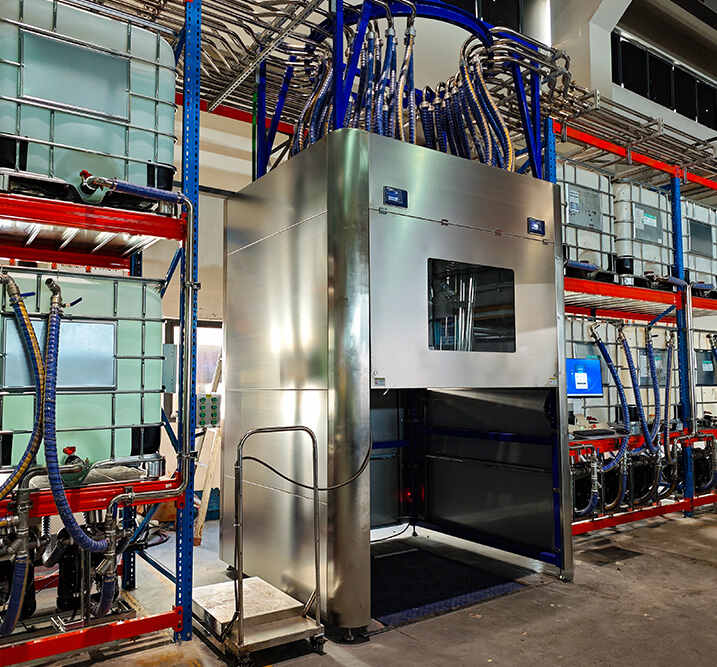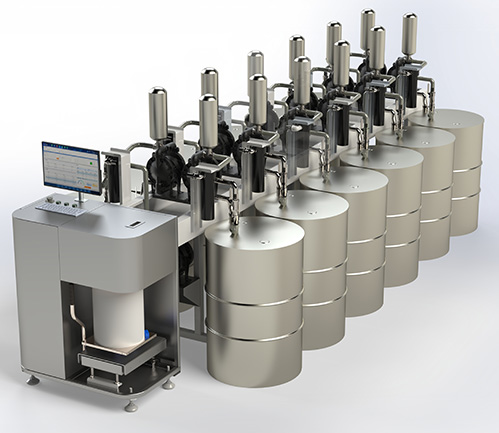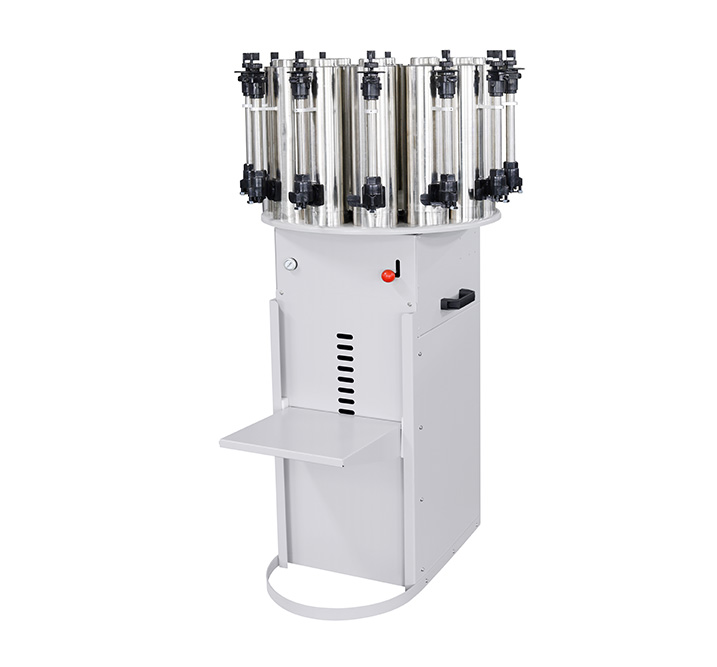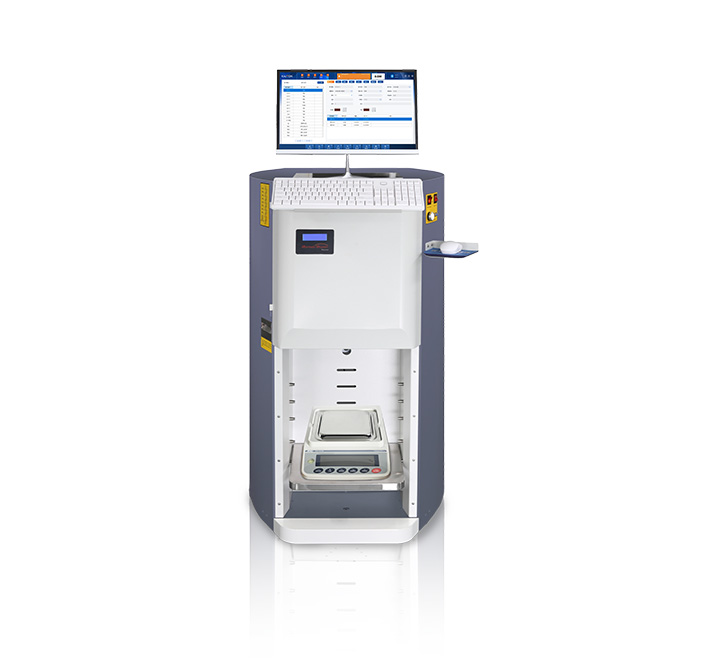I. What is a Weight-Based Paint Tinter?
1.1. Definition of a Weight-Based Color Mixing Machine
A weight-based liquid dispenser machine (or gravity-based color mixing system) represents the cutting-edge solution for modern industrial color formulation. It abandons traditional volume measurement methods and instead employs high-precision electronic weighing sensor technology. Based on a digital color formula database, it performs milligram-level precise weighing of concentrated color paste and automatically injects it into the base material. This core weighing-based measurement principle enables unparalleled color consistency, batch stability, and operational efficiency in industries such as coatings, inks, cosmetics, and polymer materials, making it the ideal intelligent equipment for achieving zero color difference production and agile supply chain management.
1.2. Classification of Weight-Based Color Mixing Machines
Weight-based color mixing machines can be categorized into the following types based on their structural design, level of automation, and application scenarios:
Classification by Mechanical Structure
1. Floor-Standing Tint Machine
Features: Independent design with color paste tanks vertically arranged on either side or at the rear of the main unit, connected to the weighing platform via a robotic arm or fixed piping.
Advantages: Supports multi-pigment expansion (up to 1,648 types), suitable for large-scale paint factories, industrial-level production scenarios, industrial-grade color matching systems, and high stability.

2. Cantilever Color Mix Machine
Features: Pigment tanks are suspended above a crossbeam, with pigment vertically dripping onto the weighing platform via precision valves.
Advantages: Space-saving, short dripping path, reduces residue buildup, suitable for retail stores and small laboratories.

Classification by Automation Level
1. Semi-Automatic Weight-Based Color Matching Machine/Manual Paint Tinting Machine
Features: Manual addition of base paint, stirring initiation, and container cleaning are required; color paste addition is automatically weighed by the system.
Application scenarios: Small to medium-sized paint stores, low-cost entry-level requirements.

2. Fully Automatic Weight-Based Auto Dispenser
Features: Integrated automatic base material addition, color paste injection, stirring, and container conveying systems, with no human intervention throughout the process.
Technical Core: Robot arm container handling, closed-loop weight feedback, and cloud-based formula management.
Application Scenarios: Automotive paint production lines, large-scale industrial paint facilities.

Classification by Color Paste Supply System
1. Single Pump Single Valve Type (Independent Pump Valve)
Principle: Each color paste tank is equipped with an independent metering pump and discharge valve, and the isolated supply system directly controls the output of color paste.
Advantages: Eliminates cross-contamination, easy maintenance, suitable for high-viscosity color paste (such as metallic paint), and high compatibility color paste management.
2. Centralized Pump + Distribution Valve Type
Principle: A shared high-pressure pump drives the color paste, and a rotating distribution valve switches the color paste channels, utilizing economical distribution valve technology.
Advantages: Low cost, compact size, suitable for scenarios with few color paste types (≤12), and compact multi-color paste management.
Risk Points: Valve core switching may cause minor color mixing.
Special Function Derivative Types
1.Portable Weight-Based Paint Dispenser:
Modular design, suitable for on-site color matching at construction sites. Keywords: mobile color matching workstation, outdoor rapid color matching.
2.Explosion-Proof Color Matching Machine:
Compliant with ATEX/IECEx certification, suitable for flammable and explosive environments (e.g., solvent-based automatic dispensing station).
3.Dual-scale redundancy system:
Dual-scale synchronous calibration with an error of <0.005g, suitable for pharmaceutical/food-grade pigment formulation. Keywords: GMP-grade weighing accuracy.
Technological Evolution Trends
Intelligence: AI formula self-learning (automatic batch color difference correction), IoT remote diagnosis.
Green: Low-residue valve design (residue <0.1g), reducing solvent consumption during cleaning.
Integration: Direct connection to MES/ERP systems, achieving closed-loop production data management.
II. Key Advantages of Weight-Based Color Mixing Machines
2.1. Core Advantages:
High Precision, Eliminating Batch Color Variation
The weight-based paint mixing machine is equipped with an industrial-grade precision balance, directly adding color paste by weight (grams/milligrams), completely eliminating measurement deviations caused by changes in color paste viscosity, piston wear, or temperature fluctuations in volume-based equipment. This ensures consistent color across every batch of products, meeting stringent quality control requirements.
Gravity-based measurement, compatible with various types of color paste
Its operating principle is unaffected by color paste viscosity, density, or rheological properties. Even when dealing with color paste from different suppliers or batches, it maintains stable addition accuracy, significantly enhancing formula adaptability and stability.
Digital formula management, intelligent and efficient
Based on a powerful central formula database system, operators only need to select the target color, and the machine will automatically calculate and execute the precise color paste weighing and addition process, significantly simplifying operations, shortening the color matching cycle, and improving production efficiency and response speed.
Modular design, flexible expansion
The system typically adopts a modular color paste station design, allowing flexible addition or reduction of color paste types and quantities according to production needs, easily addressing the challenges of flexible production with multiple varieties and small batches.
Easy maintenance, reliable operation
Compared to volumetric equipment that relies on precision pistons and cylinders, the core metering components (high-precision scales) of weight-based color matching machines experience minimal wear. Maintenance primarily involves valve cleaning and regular calibration, ensuring more reliable operation and a more advantageous total cost of ownership (TCO).
2.2. Main application scenarios:
Color hub for retail paint stores: As the core equipment for on-site instant color matching, the weight-based color matching machine enables stores to quickly and accurately mix thousands of customized wall paint colors for customers, thereby enhancing customer satisfaction and store competitiveness.
Precision assurance for industrial coating and automotive repair: In fields such as original equipment manufacturer (OEM) automotive paint, refinish paint, and industrial protective coatings, the stringent requirements for color matching perfectly highlight the high precision and repeatability advantages of the weight-based color matching machine.
Precision Manufacturing for High-End Cosmetics and Specialty Inks: Meeting the stringent standards for subtle color differences and batch consistency in industries such as cosmetics (e.g., foundation, lipstick), packaging printing inks, and plastic coloring.
2.3. The Primary Role in Tinting Paint
Weight-based color matching machines play a crucial role in paint production, directly impacting the color accuracy, quality consistency, and production efficiency of the final product. Their primary functions include:
1. High-Precision Color Matching:
Core Function: This is its fundamental role. Using high-precision weighing sensors, it accurately measures the weight of various color pastes (and sometimes resins, additives, etc.) according to pre-set formulas.
Overcoming the Limitations of Volume Measurement: Compared to traditional volume-based measurement methods (such as pumps or pistons), weight-based measurement is unaffected by changes in color paste viscosity, temperature fluctuations, or density variations caused by batch differences, resulting in significantly improved measurement accuracy (typically achieving ±0.1g or higher).
Ensuring Color Accuracy: Extremely high measurement accuracy is the foundation for ensuring that the final paint color matches the target color sample (with a low ΔE value), effectively reducing color differences between batches.
2. Enhancing Product Quality Stability:
Reducing human error: Automated operations significantly reduce potential mistakes during manual weighing and pigment addition (such as misreading scales, adding the wrong materials, or adding too much/too little).
Formulation consistency: Precisely reproducing each formulation ensures that coatings of the same color produced in different batches or at different times have highly consistent color and quality.
Meeting strict standards: For industries with extremely stringent color requirements, such as automotive and industrial coatings, weight-based color matching is critical to ensuring product quality meets customer and industry standards.
3. Improving Production Efficiency:
Automation and speed: High automation levels and simple operation (typically requiring only the input of a formula number or scanning of a barcode) enable rapid color matching, shortening production cycles.
Reduced rework: High color accuracy significantly reduces the risk and cost of re-mixing or rework due to color mismatches.
Reduced reliance on skilled labor: Simplified color matching procedures reduce the reliance on operators’ experience and skill levels.
4. Optimize Cost Control:
Reduce pigment waste: High-precision addition avoids waste caused by over-adding pigments, particularly for expensive pigments (such as certain organic pigments or special effect pigments), resulting in significant cost savings.
Reduce raw material inventory: More precise color matching reduces the need for additional inventory prepared to address color discrepancies.
Reduce quality loss costs: Avoid hidden costs such as customer complaints, returns, or rework caused by color discrepancies.
5. Formulation Management and Traceability:
Digital Storage: Formulations are stored digitally in the system for easy retrieval, management, and updates.
Production Record Traceability: The system automatically records detailed data for each color matching process (time, operator, batch and weight of color paste used, formulation number, etc.), enabling traceability of the production process for quality analysis and issue resolution.
6. Flexibility and Diversity:
Easily handle multiple varieties and small batches: Especially suitable for producing customized coatings with a wide range of colors and small batch sizes (such as retail color matching for architectural coatings or touch-up paints).
Quick color changes: System cleaning is relatively simple (especially for models with automatic cleaning functions), enabling rapid switching between different formulas for production.
7. Reduced Pollution and Waste:
Precise metering reduces waste: As mentioned earlier, reducing pigment paste waste directly reduces material consumption.
Reduced cleaning burden: Compared to volumetric equipment (pumps, pipes) that require large amounts of solvent for cleaning, weight-based color matching machines (especially models where pigment paste is directly injected into the main container or packaged separately) have fewer components requiring cleaning, resulting in less cleaning waste liquid and greater environmental friendliness.
In summary, the core value of a weight-based color matching machine in paint production lies in: Through high-precision weight measurement technology, it achieves color accuracy, consistent quality, improved efficiency, and cost savings, making it an indispensable key piece of equipment for ensuring product quality and enhancing competitiveness in modern paint production. It is particularly suitable for modern paint production environments that demand high color accuracy, handle a wide variety of colors, and prioritize production efficiency and cost control.
III. Value Summary
A weight-based color matching machine is not merely a piece of equipment; it is a critical node in the Industrial 4.0 era for achieving digitalized and precise color management. By seamlessly integrating gravity sensing with intelligent control, it provides efficient, stable, flexible, and low-maintenance color formulation solutions for various industries, fundamentally addressing the industry-wide challenge of color consistency. It is the core equipment choice for enhancing product quality, optimizing production processes, and strengthening market competitiveness. From commercial-grade compact cantilever models to industrial-grade fully automated production lines, the core focus remains on the precision of gravity sensing (accuracy up to ±0.01g) and the reliability of pigment management. Selection should comprehensively consider production capacity requirements, pigment complexity, and industry compliance standards to maximize its core value of cost reduction, efficiency improvement, and zero color difference delivery./